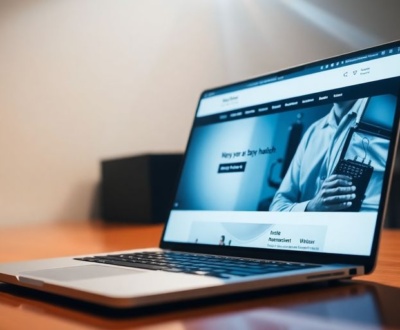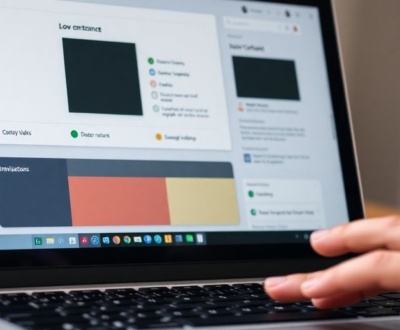Ever clicked a link only to land on a
Key Takeaways
- A custom 404 page is important for keeping users happy and on your site.
- Making a 404 page user-friendly means clear messages, a simple look, and easy ways to get around.
- Giving helpful navigation, like links to popular pages, can help users find what they need.
- Adding some fun or humor to your 404 page can make users less annoyed.
- Putting a search bar on your 404 page makes it easier for people to find what they were looking for.
Understanding the Impact of a Custom 404 Page
Generic 404 pages? They’re basically digital dead ends. Users hit a wall, get frustrated, and often just leave. But a custom 404 page? That’s a chance to keep them engaged, show off your brand’s personality, and maybe even turn a negative into a positive. It’s more than just error handling; it’s about user experience.
Beyond Standard Error Handling
Think of a custom 404 page as a safety net. Instead of a blunt "Page Not Found," you’re offering a helping hand. It’s a chance to show you care about the user’s experience, even when things go wrong. It’s about going beyond the bare minimum and providing something useful and maybe even delightful. This is not just about displaying an error message; it’s about maintaining a positive user experience.
Enhancing User Retention and Conversion
A well-designed 404 page can keep users on your site. If you provide helpful links, a search bar, or even just some entertaining content, you’re giving them a reason to stick around. And the longer they stay, the more likely they are to find what they were originally looking for, or discover something new. This can directly impact your conversion rates.
Transforming Negative Experiences into Positive Interactions
Turning a 404 error into a positive interaction? It’s totally possible. A little humor, a creative design, or a genuinely helpful message can go a long way. It shows that you’re not just a faceless website, but a brand with a personality. It’s an opportunity to build goodwill and make a lasting impression. Consider adding a search bar to help users find what they need.
Key Elements of an Effective Custom 404 Page
So, you’re thinking about sprucing up your 404 page? Smart move! A well-crafted 404 page isn’t just about saying "oops, page not found." It’s a chance to keep users engaged and guide them back to where they need to be. Let’s break down the key elements that make a 404 page truly effective.
Clear and User-Friendly Messaging
The most important thing is to communicate clearly. No one likes cryptic error messages. Instead of a generic "404 Error," try something friendly like, "Oops! We can’t seem to find the page you’re looking for." This approach is way more approachable and less frustrating. Make sure the message is easy to understand and tells the user what happened. A little bit of empathy goes a long way. Think of it as a digital helping hand, not a digital dead end. You can even include a brief explanation of why they might be seeing the error, such as a broken link or a mistyped URL. This helps manage expectations and shows you care about their experience. A user-friendly error message can significantly improve user satisfaction.
Consistent Brand Design and Tone
Your 404 page should feel like a natural extension of your website. That means keeping the design consistent with your brand. Use your brand colors, logo, and fonts. This helps maintain a cohesive experience and reinforces your brand identity, even when something goes wrong. It’s a missed opportunity to build brand recognition. Also, consider your brand’s tone. If your brand is playful, inject some humor into the 404 page. If it’s more serious, keep the tone professional and helpful. The goal is to make the 404 page feel like it belongs to your website, not some random error screen. This consistency helps users feel more comfortable and less disoriented. A consistent brand design reinforces your brand identity.
Helpful Navigation Options
Don’t just leave users stranded on a 404 page. Give them options to get back on track. Here are a few ideas:
- Link to your homepage: This is the most basic and essential navigation option.
- Link to your site map: This allows users to see the overall structure of your website and find what they’re looking for.
- Links to popular pages: Highlight your most visited or important pages to guide users to relevant content.
- A search bar: This allows users to search for specific content directly from the 404 page.
Providing these navigation options helps users quickly find what they need and reduces the chances of them leaving your site in frustration. Think of it as offering a digital roadmap to guide them back to their destination. The easier it is for users to navigate, the more likely they are to stay engaged with your website. Helpful navigation options can significantly reduce bounce rates.
Designing for User Experience on a Custom 404 Page
It’s easy to overlook the 404 page, but it’s a real opportunity to keep users happy, even when they hit a dead end. A well-thought-out 404 page can turn a negative into a positive. Let’s talk about how to make these pages work for your users.
Prioritizing Visual Appeal and Functionality
Your 404 page should look good and be easy to use. It’s not enough for it to just exist. Think about the overall design. Is it clean? Is the text easy to read? Does it load quickly? A cluttered, slow-loading page will only frustrate users more. Make sure it works well on phones and tablets too. A good-looking, functional 404 page shows you care about the user experience, even when things go wrong.
Incorporating Brand Identity Elements
Your 404 page is still part of your website, so it should feel like it. Use your brand’s colors, fonts, and logo. This helps users know they’re still in the right place. It also reinforces your brand identity, even on an error page. Don’t miss this chance to keep your brand consistent.
Ensuring Accessibility and Responsiveness
Make sure everyone can use your 404 page, including people with disabilities. Use alt text for images, make sure the text is readable, and ensure the page is easy to navigate with a keyboard. Also, the page needs to look and work well on all devices, from desktops to phones. A responsive design is key. If your 404 page isn’t accessible and responsive, you’re missing out on reaching a large number of potential users.
A well-designed 404 page is more than just a technical fix; it’s a reflection of your brand’s commitment to user experience. By focusing on visual appeal, brand consistency, and accessibility, you can transform a potential frustration point into a positive interaction.
Practical Features for a Functional Custom 404 Page
Integrating a Search Bar for Content Discovery
A search bar is a game-changer on a 404 page. Instead of leaving users stranded, you’re giving them a direct way to find what they were looking for. It’s like saying, "Oops, we messed up, but here’s how you can still find what you need." This is especially helpful if users mistype a URL or if you’ve reorganized your site. A prominent search bar can significantly improve the user experience and keep people on your site longer. It’s a simple addition that can make a big difference. Make sure the search functionality is easy to use.
Providing Clear Calls-to-Action
Calls-to-action (CTAs) are essential for guiding users after they land on a 404 page. Don’t just tell them the page isn’t found; tell them what they can do. Here are some ideas:
- "Return to Homepage": A simple and direct way to get users back to familiar territory.
- "Browse Our Products": If you run an e-commerce site, this can lead users to your main offerings.
- "Contact Us": For users who need specific help, provide a direct line to customer support.
CTAs should be clear, concise, and visually appealing. Use action-oriented language and make sure the buttons or links stand out. The goal is to turn a negative experience into an opportunity for further engagement.
Offering Links to Relevant Content
Instead of a generic error message, why not offer some helpful suggestions? Think about the types of content users are most likely looking for and provide direct links. This could include:
- Links to popular blog posts
- Links to key product pages
- Links to your site map
Offering relevant links shows that you’re thinking about the user’s needs and trying to help them find what they’re looking for. This can significantly reduce frustration and improve the overall website experience. It also helps to minimize user abandonment of your site.
Leveraging Creativity and Humor in Custom 404 Page Design
It’s easy to think of a 404 page as a dead end, but it’s actually a chance to show off your brand’s personality. A little creativity can go a long way in turning a frustrating moment into something memorable. Think of it as a chance to integrate brand identity and make a lasting impression, even when things go wrong.
Engaging Users with Unique Visuals
Forget the boring, standard error messages. Use visuals that grab attention! This could be anything from custom illustrations to quirky animations. The key is to make it relevant to your brand and engaging enough that users don’t immediately bounce. A well-placed, eye-catching graphic can make all the difference. Think about what kind of visuals would resonate with your target audience and use that as your guide.
Reducing Frustration Through Playful Messaging
Humor can be a great way to diffuse the frustration of landing on a 404 page. A clever, lighthearted message can turn a negative experience into a positive one. Just be sure the humor aligns with your brand’s tone and doesn’t come across as insensitive or out of touch.
Here are some ideas:
- A pun related to your industry.
- A self-deprecating joke about the missing page.
- A playful explanation of why the page might be missing.
Remember, the goal is to acknowledge the error while keeping the user engaged and entertained. A little bit of wit can go a long way in turning a potential exit into continued browsing.
Reinforcing Brand Personality
Your 404 page is an extension of your brand. Use it to reinforce your brand’s personality and values. If your brand is known for being playful and quirky, let that shine through in your 404 page design. If your brand is more serious and professional, opt for a more understated approach. The important thing is to be consistent with your overall brand image. Think about using your brand’s mascot in a fun animation or incorporating your signature colors into the design. This helps to create animated 404 pages that are both memorable and on-brand.
Strategic Benefits of a Well-Designed Custom 404 Page

Minimizing Bounce Rates and User Abandonment
Generic 404 pages are user-repellent. They offer no help, no direction, and often lead to immediate abandonment of your site. A well-crafted custom 404 page, however, can significantly reduce bounce rates. By providing helpful links, a search bar, or even just a friendly message, you give users a reason to stick around and explore other parts of your website. Think of it as a second chance to keep them engaged. It’s about turning a potential dead end into a new path for discovery. A bad 404 error page might make visitors leave immediately.
Fostering Connection with Your Audience
A custom 404 page is a golden opportunity to showcase your brand’s personality. It’s a place where you can use humor, creativity, and a unique voice to connect with your audience on a more personal level. It shows that you care about their experience, even when things go wrong. This can lead to increased brand loyalty and a stronger connection with your visitors. It’s not just about fixing an error; it’s about building a relationship. A positive interaction with the brand can lead to meaningful experiences.
Improving Overall Website Experience
Think of your custom 404 page as an integral part of your website’s overall user experience. It’s not just a fallback; it’s a chance to make a positive impression, even in the face of an error. By providing helpful resources, clear navigation, and a touch of personality, you can turn a potentially frustrating experience into a surprisingly pleasant one. This contributes to a more positive perception of your website and encourages users to return in the future. It’s about showing that you’ve thought about every aspect of their journey, even the unexpected detours. A custom 404 page is important for maintaining a positive user experience.
A well-designed 404 page isn’t just about fixing an error; it’s about enhancing the overall user experience and reinforcing your brand’s identity. It’s a chance to turn a negative into a positive and leave a lasting impression on your visitors.
Monitoring and Optimizing Your Custom 404 Page

So, you’ve got a fancy custom 404 page up and running. Great! But the job isn’t done. You need to keep an eye on how it’s performing and make tweaks as needed. Think of it like tending a garden – you can’t just plant the seeds and walk away. You gotta water, weed, and maybe even move things around to help them grow.
Analyzing User Behavior on Error Pages
The first step is to actually look at what people are doing when they hit your 404 page. Are they clicking on the links you provided? Are they using the search bar? Or are they just bouncing right off the page? Analytics tools are your best friend here. Set up tracking to see which pages are generating the most 404 errors. This can point to broken links or content that’s been moved without proper redirects. Understanding this behavior is key to making improvements.
Gaining Insights for Website Improvement
Your 404 page isn’t just a place to say "oops." It’s a goldmine of information about what’s not working on your site. If people are constantly landing on a 404 when trying to reach a specific product, that’s a sign you need to fix the link or update your navigation.
Think of your 404 page as a feedback mechanism. It tells you where users are getting lost, so you can guide them back on the right path.
Here’s a simple example:
| Error Type | Frequency | Action Needed |
|---|---|---|
| Broken Product Link | 50/week | Update product link across all pages |
| Old Blog Post | 25/week | Redirect to a related, newer blog post |
| Typo in URL | 10/week | No immediate action, but monitor for patterns |
Implementing Redirects for Broken Links
Okay, you’ve identified some broken links. Now what? The best solution is often to set up redirects. A redirect automatically sends users from the broken link to a working page. This could be the new location of the content, a related page, or even just your homepage. Redirects make sure users don’t get stuck on a dead end. It’s a simple fix that can make a big difference in user experience. It’s also good for SEO, since search engines don’t like broken links either.
Here are some options for redirects:
- 301 Redirect: Permanent redirect, best for content that has moved permanently.
- 302 Redirect: Temporary redirect, useful if the content will be back at the original URL soon.
- Manual Redirect: Using code in your .htaccess file (if you’re on Apache) or through your CMS.
Conclusion
So, there you have it. A custom 404 page isn’t just some small detail; it’s a big deal for keeping people happy on your site. When someone hits a dead end, you want to make sure they don’t just leave. By making your 404 page clear, easy to use, and maybe even a little fun, you can turn a bad moment into a chance to show off your brand. It’s all about making sure visitors feel good, even when things go wrong, and helping them find what they’re looking for. A little effort here goes a long way in making your website a better place for everyone.
Frequently Asked Questions
What exactly is a 404 page?
A 404 page pops up when you try to visit a web page that doesn’t exist or can’t be found. Think of it like a ‘dead end’ sign on the internet.
Why is it a big deal to have a good 404 page?
Having a well-made 404 page is super important! It helps keep visitors on your site even if they hit a broken link. It also makes your website feel more professional and user-friendly, guiding people back to what they’re looking for.
What are some good tips for making a 404 page?
To make a great 404 page, you should have a clear message that says ‘oops, page not found,’ but in a friendly way. Also, add a search bar or links to other important parts of your site. Make sure it looks like the rest of your website too!
Can I use humor or cool designs on my 404 page?
Yes, definitely! Adding a bit of fun or a cool picture can turn a bad moment (finding an error) into a positive one. It shows your brand’s personality and can make people smile instead of getting frustrated.
Should I put a search bar on my 404 page?
A search bar is a fantastic idea! It lets people type in what they were looking for, helping them find the right page quickly without having to go back to the beginning of your site.
How do I know if my 404 page is working well?
You should regularly check how many people land on your 404 page and where they go next. This helps you fix broken links and make your website better overall. It’s like checking a map to see if you’re sending people in the right direction.
About this blog
We are a digital marketing company with a focus on helping our customers achieve great results across several key areas.
Request a free quote
We offer professional SEO services that help websites increase their organic search score drastically in order to compete for the highest rankings even when it comes to highly competitive keywords.









